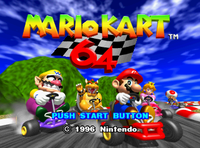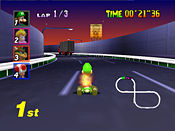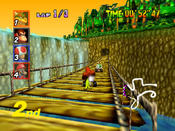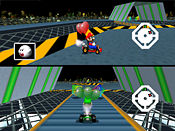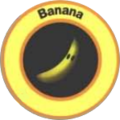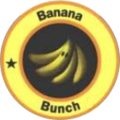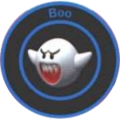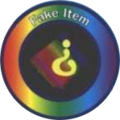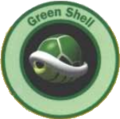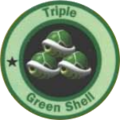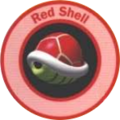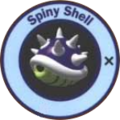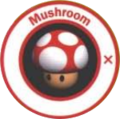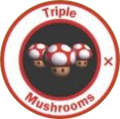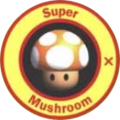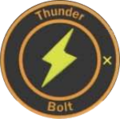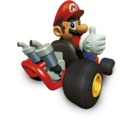Mario Kart 64: Difference between revisions
| Line 94: | Line 94: | ||
File:MK64Peach.PNG | {{color-link-piped|Princess Peach|blue|Peach}} | File:MK64Peach.PNG | {{color-link-piped|Princess Peach|blue|Peach}} | ||
File:MK64Toad.PNG | {{color-link|Toad|blue}} | File:MK64Toad.PNG | {{color-link|Toad|blue}} | ||
File:MK64Yoshi.PNG | {{color-link|Yoshi| | File:MK64Yoshi.PNG | {{color-link|Yoshi|bluegreen}} | ||
File:MK64Wario.png | {{color-link|Wario|red}}* | File:MK64Wario.png | {{color-link|Wario|red}}* | ||
File:MK64D.K..png | {{color-link|Donkey Kong|red}}* | File:MK64D.K..png | {{color-link|Donkey Kong|red}}* | ||
Revision as of 15:31, February 10, 2015
Template:Infobox Mario Kart 64 is the second installment of the Mario Kart series. This is also the first in the series to use three-dimensional graphics. It was released for the Nintendo 64, and later became available for the Wii's Virtual Console. It featured changes in playable characters, new courses, and was placed 4th in the 100th issue of Nintendo Power's "100 best Nintendo games of all time" in 1997.[1] Mario Kart 64 has set many trends which have continued on in the Mario Kart series, such as Drifting and Item Boxes. Additionally, every course and battle arena has reappeared in future Mario Kart games except for Wario Stadium and Double Deck.
Gameplay
Players must steer with the Nintendo 64's controller's control stick, holding ![]() down to accelerate.
down to accelerate. ![]() is used for braking, and also allows the players to reverse by pointing the control stick down. Items can be used by simply pressing the
is used for braking, and also allows the players to reverse by pointing the control stick down. Items can be used by simply pressing the ![]() trigger. When players press the
trigger. When players press the trigger, they jump, allowing the kart to turn around tight corners. Turning too much or quickly, or turning side to side, results in a spinout, making the Kart stop for several seconds. If a Banana is hit while the player is driving straight, the character will skid for a while before spinning out. If the player presses the
![]() button, a music note will appear over the character's head, nullifying the effect of the item (this effect is also included in Mario Kart: Super Circuit). This does not work all the time, however, because sometimes, the player can skid out immediately after driving into a banana if the banana is hit while turning.
button, a music note will appear over the character's head, nullifying the effect of the item (this effect is also included in Mario Kart: Super Circuit). This does not work all the time, however, because sometimes, the player can skid out immediately after driving into a banana if the banana is hit while turning.
As opposed to the previous game in the series, Super Mario Kart, a standard race now has three laps rather than five due to the much-longer raceways compared to those found in Super Mario Kart. Additionally, the race tracks have elevation and feature different forms of terrain. To get items, the character must get an Item Box. Once the character gets an Item Box, an item-roulette will appear with medium sound, and, when it stops, "dings". Players can press the item button during the roulette to stop the roulette early. Also unlike Super Mario Kart, Players have Infinite Chances and can now try again as many times as they wish after they finish in 5th or below. This was removed in later games for unknown reasons.
There are four cups, designated as Mushroom Cup, Flower Cup, Star Cup, and Special Cup. These cups are further divided into three different difficulty settings of 50cc, 100cc, or 150cc. An unlockable Extra, known as Mirror Mode, allows players to race courses flipped vertically, which sometimes increases difficulty. In order to unlock this feature, players must win the Gold Cup on all the cups in 150cc. When the title screen changes, it means that the player has unlocked Extra. A Time Trial mode and a Battle Mode are also available, which pit players in different Kart scenarios that do not necessarily require racing.
In the Time Trial mode, players must race against their own previous times, represented by a Ghost of their player-of-choice.
In Battle Mode, each player starts with three balloons and loses a balloon when hit by any item. It is also possible to lose a Balloon if a heavier player such as Bowser hits a lighter player like Toad or Yoshi with great enough speed (more details here). When a player has lost all Balloons, the player loses and becomes a Bomb Kart. The last surviving player wins the round.
The rival system in this game is the more common 2 Rival system seen in most similar games, whereupon two randomly selected rivals will fight with the player, and will use the "Handicap" feature to situate themselves on level with the player. They will always stay on the same, no matter what the championship standings are.
On a side note, when the player plays the 150cc and Extra mode, two random CPU racers may receive a huge handicap, and even when hit with an item such as a Red Shell, they will recover rapidly. Sometimes there is also one player that receives an even larger handicap and when ahead, it is almost impossible to stop the player without cheating.
Button controls
Nintendo 64
 - Accelerate, Rocket Start
- Accelerate, Rocket Start - Brake
- Brake - Zoom In/Out
- Zoom In/Out /
/ - Switch screen positions
- Switch screen positions - Use items, stop Item Roulette
- Use items, stop Item Roulette - Select option during the Menus/Pause or resume during gameplay
- Select option during the Menus/Pause or resume during gameplay - Use items, stop Item Roulette
- Use items, stop Item Roulette- Drift
- Lower music volume
 - Steer
- Steer- change option during the Menus
Wii Virtual Console
Classic controller
 - Accelerate, Rocket Start
- Accelerate, Rocket Start - Brake
- Brake - Use items, stop Item Roulette
- Use items, stop Item Roulette - Use items, stop Item Roulette
- Use items, stop Item Roulette - change options during the Menus
- change options during the Menus- Steer
up - Zoom In/Out
left/right - switch screen positions
down - Use items, stop Item Roulette
 - Use items, stop Item Roulette
- Use items, stop Item Roulette - Drift
- Drift - Pause/Resume during gameplay
- Pause/Resume during gameplay - Lower music volume
- Lower music volume
GameCube controller
 - Accelerate, Rocket Start
- Accelerate, Rocket Start - Brake
- Brake up - Zoom In/Out
up - Zoom In/Out left/right - Switch screen positions
left/right - Switch screen positions down - Use items, stop Item Roulette
down - Use items, stop Item Roulette - Pause/Resume during game play
- Pause/Resume during game play - Use items, stop Item Roulette
- Use items, stop Item Roulette - Use items, stop Item Roulette
- Use items, stop Item Roulette - Lower music volume
- Lower music volume - Drift
- Drift - Use items, stop Item Roulette
- Use items, stop Item Roulette - Steer
- Steer - Change options during the Menus.
- Change options during the Menus.
Technical
The original release of this game on the Nintendo 64 used 123 pages of the Controller Pak to record Ghost Data, which would occupy all the space in the Controller Pak. However, later versions of the game used 121 pages on the Controller Pak, leaving only 2 pages free.
Because none of the available controllers have a Controller Pak Slot, it is impossible to record Ghost Data on the Virtual Console version of the game.
Drivers
Characters are divided into three classes depending on their weight: Light, Medium, and Heavy.
* indicates that the character is a New Driver for the Mario Kart installments overall.
Lightweight drivers have the highest acceleration and highest top speed. Additionally, only Lightweights (and the heavyweight character Bowser) can use the triple-gas acceleration recovery technique (tapping the gas button three times and then holding to accelerate more quickly). The single downside to lightweight characters is that they can spin out from contact with heavier characters.
Middleweight drivers actually have the slowest acceleration of all the weight classes and have the same top speed as the heavyweights.
Heavyweight drivers have a slower acceleration than the lightweights, but faster acceleration than the middleweights and share the same top speed as the middleweights.
Analysis and Tiering of the above weight categories is demonstrated in the this video.
- Additionally, players can drive a Mini Bomb Kart when all their balloons disappear in battle mode. The Mini Bomb Kart can drive around and explode on other players, but it only has one use for exploding before completely disappearing.
Enemies
- Bat
- Boo
- Chain Chomp
- Crab
- Mini Bomb Kart (VS mode only)
- Chubby
- Penguin
- Piranha Plant
- Snowman
- Spiny
- Thwomp
- Yoshi Egg
Non-Playable
Obstacles
- Train (Kalimari Desert)
- Lava (Bowser's Castle)
- Water
- Icy Water (Sherbet Land)
- Grass
- Sand
- Mud
- Cactus (Kalimari Desert)
- Boulders (Choco Mountain)
- Cars/Trucks (Toad's Turnpike)
Courses
Race courses
- File:MK64 MushroomCup.jpg
- LuigiRaceway.png
Luigi Raceway
717 m - MooMooFarm.png
Moo Moo Farm
527 m - KoopaTroopaBeach.png
Koopa Troopa Beach
691 m - KalimariDesert.png
Kalimari Desert
753 m
- File:MK64 FlowerCup.jpg
- ToadsTurnpike.png
Toad's Turnpike
1036 m - FrappeSnowland.png
Frappe Snowland
734 m - ChocoMountain.png
Choco Mountain
678 m - MarioRaceway.png
Mario Raceway
567 m
- File:MK64 StarCup.jpg
- WarioStadium.png
Wario Stadium
1591 m - SherbetLand.png
Sherbet Land
756 m - RoyalRaceway.png
Royal Raceway
1025 m - Bowser'sCastle.png
Bowser's Castle
777 m
- File:MK64 SpecialCup.jpg
- DK'sJungleParkway.png
D.K.'s Jungle Parkway
893 m - YoshiValley.png
Yoshi Valley
772 m - BansheeBoardwalk.png
Banshee Boardwalk
747 m - RainbowRoadMK64.png
Rainbow Road
2000 m
Battle stages
- BigDonut.png
- BlockFort.png
- DoubleDecker.png
- SkyScraper.png
Items
* - Can be used multiple times.
X - Do not appear in the Battle Mode.
References to other games
- Super Mario Kart - In the music of the track Banshee Boardwalk, you can hear a part of Ghost Valley music.
- Super Mario 64 - In the track Royal Raceway, there is a part where the racer can turn off the road and arrive at Princess Peach's Castle exactly as it appeared in this game. It is also where the award ceremony is held.
- Donkey Kong Country - This is the first appearance of the Donkey Kong Country version of Donkey Kong in the main Mario franchise. In fact, the sprite was partially taken from that game.
References in later games
- Mario Kart: Super Circuit: Many graphics from this game were reused, such as characters, karts, and character screen portraits. A similar thing that while losing characters turn into a Mini Bomb Kart in Super Mario 64, losing characters turn into Bob-ombs in Mario Kart: Super Circuit.
- Mario Kart: Double Dash!!: The name Sherbet Land is reused in this game. Also, Rainbow Road's music has a remixed part from Rainbow Road in this game.
- Animal Crossing: Wild World, City Folk, and New Leaf: The song K.K. Country is a remix of the song that plays on Choco Mountain, Double Deck, and Block Fort.
- Mario Kart DS: The name Wario Stadium is reused in this game. Also, the courses Moo Moo Farm, Frappe Snowland, Choco Mountain, Banshee Boardwalk, and the battle stage Block Fort reappear in this game.
- Mario Kart Wii: The course Moo Moo Meadows is based off of Moo Moo Farm. Also, the courses Mario Raceway, Sherbet Land, DK's Jungle Parkway, Bowser's Castle, and the battle stage Skyscraper reappear in this game.
- New Super Mario Bros. Wii: A section of Rainbow Road is covered in World 9's music.
- Mario Kart 7: Some of the music tracks are covers or rearranged versions of themes from Mario Kart 64, like Rainbow Road. Also, the courses Luigi Raceway, Koopa Troopa Beach, Kalimari Desert, and the battle stage Big Donut reappear in this game. The Pipe Frame is similar to the karts in this game. Mario Kart 64's winning results have been remixed in Mario Kart 7
- Mario Kart 8: Toad's Turnpike, Royal Raceway, Yoshi Valley and Rainbow Road reappear in this game. The unused spilt screen for multiplayer in this game is also used here.
<youtube width="320" height="265" align="right">akdLMnIV7Jc</youtube>
Awards
- Longest Track in the Mario Kart Series - Rainbow Road - Guinness Book of World Records Gamers Edition 2009 - 2013
Media
Staff
- Main article: List of Mario Kart 64 staff
Executive Producer
Producer
Director
- Hideki Konno
Music Composer
Beta elements
- Main article: List of Mario Kart 64 beta elements
Kamek was originally intended to be one of the playable characters, but ended up being replaced by Donkey Kong. The Character Select screen was also different, the characters faced the player, and Kamek can be seen in Donkey Kong's space. The working title of this game was Super Mario Kart R. Boos from Banshee Boardwalk also had a different look, the HUD was different from the final version, and item boxes were also completely black with colored question marks on them. The Cape Feather, which was in Super Mario Kart, was also intended to be included, as seen in a certain screenshot of Super Mario Kart R. This particular screenshot can been seen on the back of the packaging of the Nintendo 64 system.
Glitches
- Main article: List of glitches in Mario Kart 64
Template:Conjecturaltext
This glitch works in any mode with any player on Wario Stadium. On the first hill after the start of the race, the player should drive into the wall, they should be able to bounce over it. Next, they should do a 180 degree turn and aim for the starting pole (the player is over the wall so it may be hard to see it depending on how well the Nintendo 64 or Wii works). The player should hop over the wall again and make sure to land to the right of the starting line. Once the player crosses the starting line after they regain control of their kart, Lakitu should hold the second or Final lap sign, depending on which lap the player was on previously, or he will wave the checkered flag, if the race is finished.
Template:Conjecturaltext
To perform this glitch start a battle on Double Deck. The player must then park one of the characters over an Item Box and make sure that the character doesn't receive a Boo or Star. Then have the other character(s) loose their balloons. On the Battle Ranking screen, keep pressing Z on the controller for the character that is on the item box. Eventually the game will freeze with the music still playing.
Gallery
Name in other languages
Trivia
- In the Japanese version, Luigi, Toad, Peach, and Wario have different voice overs than their American counterparts, while other characters do not. The Japanese voice overs were used in the first two Mario Party games and Mario Kart: Super Circuit. Also, Toad, Donkey Kong, and Bowser are referred to as Kinopio, D. Kong, and Koopa.
- This is one of the two games that marks the first time, Luigi, Yoshi, Donkey Kong, and Wario receive a revamped appearance from the original hand-drawn era to the N64 3-D art direction of the Mario franchise, the other being Super Mario 64.
- This game currently has the most featured tracks in Retro Courses (15), the only one to not appear in any other game is Wario Stadium.
- Mario Kart 64 is the only Mario Kart game outside of Japan to not have at least one track named 'Mario Circuit', as the Circuits are referred to as "Raceways" outside Japan.
- Toad and Donkey Kong are the only drivers to have their karts' engine sounds not shared with the other drivers. Mario's is shared with Luigi's, Peach's is shared with Yoshi's, and Wario's is shared with Bowser's.
- This is the only game in the Mario Kart series where all the included characters have their signature courses. In other games, only selected characters have their signature courses.
References
- ^ http://www.gamekult.com/communaute/forum/voirmessage.html?foid=13000909, retrieved 6/4/2009
Template:MK Players Template:Mariogames
| Nintendo 64 games | ||
|---|---|---|
| Super Mario franchise | Super Mario 64 (1996) • Mario Kart 64 (1996) • Mario no Photopi (1998) • Mario Party (1998) • Mario Golf (1999) • Mario Artist: Paint Studio* (1999) • Mario Party 2 (1999) • Mario Artist: Talent Studio* (2000) • Mario Artist: Communication Kit* (2000) • Mario Tennis (2000) • Paper Mario (2000) • Mario Artist: Polygon Studio* (2000) • Mario Party 3 (2000) • Dr. Mario 64 (2001) | |
| Donkey Kong franchise | Diddy Kong Racing (1997) • Donkey Kong 64 (1999) | |
| Yoshi franchise | Yoshi's Story (1997) | |
| Crossovers | Super Smash Bros. (1999) | |
